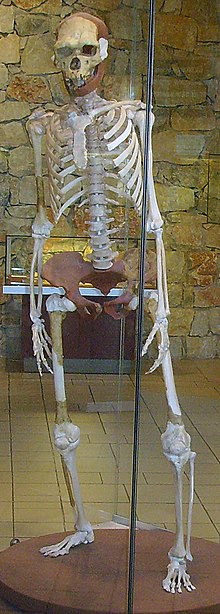
Back Homo erectus Afrikaans Homo erectus AN إنسان منتصب Arabic هومو إيريكتوس ARY هومو إريكتوس ARZ Homo erectus AST Erektus Azerbaijani Homo Erectus BAR Homo erectus Byelorussian Изправен човек Bulgarian
| Homo erectus | |
|---|---|
| 1,9 Ma-0,143 Ma | |
 | |
| Sailkapen zientifikoa | |
| Klasea | Mammalia |
| Ordena | Primates |
| Familia | Hominidae |
| Leinua | Hominini |
| Generoa | Homo |
| Espeziea | Homo erectus (Dubois, 1892)
|
Homo erectusa (Zutik ibiltzeko gai zen gizakia) iraungitako hominido bat da, duela 1,9 miloi eta 143.000[1][2] edo 50.000[3] urte bitartean bizi izan zena. Lehen fosilak Eugène Dubois mediku holandarrak Indonesiako Java uhartean 1891n aurkitu zituen eta Pithecantropus erectus deitu zion. Geroztik, Homo erectusari dagozkion fosilak Afrikan (Tanzanian, Hegoafrikan eta Aljerian), Europan (Alemanian, Espainian, Frantzian, Grezian eta Hungarian) eta Asian (Indonesian eta Txinan) aurkitu dira, baina horietako askoren sailkapenak hizpide eman du[4][5]
Eztabaida irekita dago Homo erectusaren arbaso eta ondorengotzaren inguruan, batez ere Homo ergasterrari dagokionez. Autore batzuen arabera, H. erectusa eta H. ergasterra espezie bera dira eta, beraz, H. erectusa ondorengo hominino guztien arbaso da, Homo heidelbergensisa, Homo neanderthalensisa eta Homo sapiensa barne; edo, bestela, H. erectusa Asiako espezie bat da, H. ergasterarren ezberdina[4][6]. Beste paleontropologo batzuen arabera, H. ergasterra H. erectusaren Afrikako barietatea da; horregatik, "Homo erectus sensu stricto" Asiako espezieaz ari direnan erabiltzen dute eta "Homo erectus sensu lato" beste populazio edo azpiespezie batzuez hitz egitean, bereziki Afrikan[7][8]. 2013an beste eztabaida bat ireki zen Dmanisiko buruhezurrak aurkitu zirenean[9]: hain ziren ezberdinak non, ikerlarien ustez, Homo ergasterra eta Homo rudolfensisa eta, agian, Homo habilisa ere H. erectusaren barruan sailkatu behar liratekeen[10][11].
Dena dela, H. erectusa lantzak, aiztoak eta beste hainbat tresna zurez, harriz nahiz hezurrez egiteko gai zen[12][13]. Sua janaria prestatzeko erabili izanaren aztarnak ere aurkitu dira[14][15][16]. Hominido horrek bi oinen gainean ibiltzeko gaitasuna zuen, eta 750 eta 1.100 cm³ bitarteko buruhezur-edukiera[17].
- ↑ (Ingelesez) «Scientists show that modern humans never co-existed with Homo erectus» Smithsonian Insider 2011-07-06 (Noiz kontsultatua: 2017-08-23).
- ↑ (Ingelesez) Homo erectus | The Smithsonian Institution's Human Origins Program. (Noiz kontsultatua: 2017-08-23).
- ↑ Swisher, C. C.; Rink, W. J.; Antón, S. C.; Schwarcz, H. P.; Curtis, G. H.; Suprijo, A.; Widiasmoro. (1996). «Latest Homo erectus of Java: Potential Contemporaneity with Homo sapiens in Southeast Asia» Science 274 (5294): 1870–1874. doi:. (Noiz kontsultatua: 2017-08-23).
- ↑ a b Hazarika, M. (2007). Homo erectus/ergaster and Out of Africa: recent developmets in paleoanthropology and prehistoric archaelogy. .
- ↑ Chauhan, Parth R. "An overview of the Siwalik Acheulian and reconsidering its chronological relationship with the Soanian–A theoretical perspective." Assemblage 7 (2003): 1-28
- ↑ G., Klein, Richard. (1999). The human career : human biological and cultural origins. (2nd ed. argitaraldia) University of Chicago Press ISBN 0226439631..
- ↑ (Ingelesez) Antón, Susan C.. (2003-01-01). «Natural history of Homo erectus» American Journal of Physical Anthropology 122 (S37): 126–170. doi:. ISSN 1096-8644. (Noiz kontsultatua: 2017-08-23).
- ↑ Suwa, Gen; Asfaw, Berhane; Haile-Selassie, Yohannes; White, Tim; Katoh, Shigehiro; Woldegabriel, Giday; Hart, William K.; Nakaya, Hideo et al.. (2007). «Early Pleistocene Homo erectus fossils from Konso, southern Ethiopia» Anthropological Science 115 (2): 133–151. doi:. (Noiz kontsultatua: 2017-08-23).
- ↑ (Ingelesez) Perkins, Sid. «Skull suggests three early human species were one» Nature doi:. (Noiz kontsultatua: 2017-08-23).
- ↑ (Ingelesez) Lordkipanidze, David; León, Marcia S. Ponce de; Margvelashvili, Ann; Rak, Yoel; Rightmire, G. Philip; Vekua, Abesalom; Zollikofer, Christoph P. E.. (2013-10-18). «A Complete Skull from Dmanisi, Georgia, and the Evolutionary Biology of Early Homo» Science 342 (6156): 326–331. doi:. ISSN 0036-8075. PMID 24136960. (Noiz kontsultatua: 2017-08-23).
- ↑ Beautiful Skull Spurs Debate on Human History. 2013-10-19 (Noiz kontsultatua: 2017-08-23).
- ↑ McDougal Littell world history : patterns of interaction. McDougal Littell 1999 ISBN 039587274X..
- ↑ (Ingelesez) Humans Shaped Stone Axes 1.8 Million Years Ago, Study Says - The Earth Institute - Columbia University. (Noiz kontsultatua: 2017-08-23).
- ↑ James, Steven R.; Dennell, R. W.; Gilbert, Allan S.; Lewis, Henry T.; Gowlett, J. a. J.; Lynch, Thomas F.; McGrew, W. C.; Peters, Charles R. et al.. (1989-02-01). «Hominid Use of Fire in the Lower and Middle Pleistocene: A Review of the Evidence [and Comments and Replies»] Current Anthropology 30 (1): 1–26. doi:. ISSN 0011-3204. (Noiz kontsultatua: 2017-08-23).
- ↑ BBC NEWS | Science/Nature | Early human fire skills revealed. (Noiz kontsultatua: 2017-08-23).
- ↑ «Quest for Fire Began Earlier Than Thought - ScienceNOW» archive.is 2013-04-15 (Noiz kontsultatua: 2017-08-23).
- ↑ (Ingelesez) Holloway, Ralph L.. (1981-08-01). «The Indonesian Homo erectus brain endocasts revisited» American Journal of Physical Anthropology 55 (4): 503–521. doi:. ISSN 1096-8644. (Noiz kontsultatua: 2017-08-23).